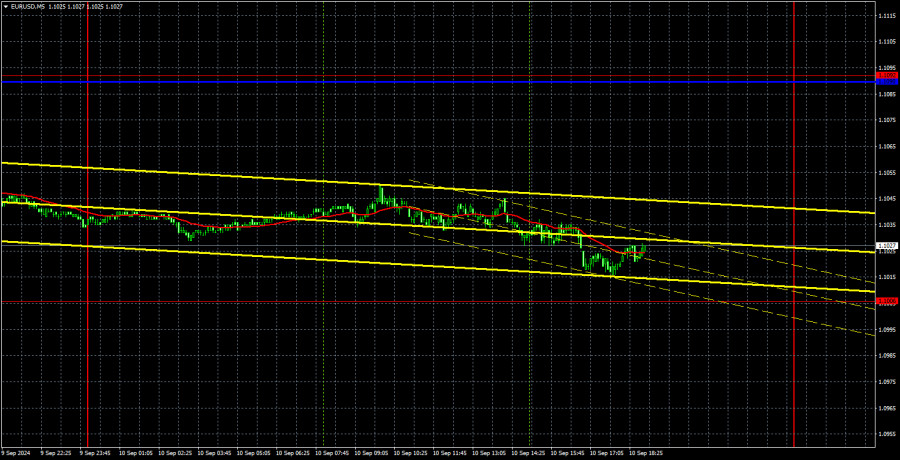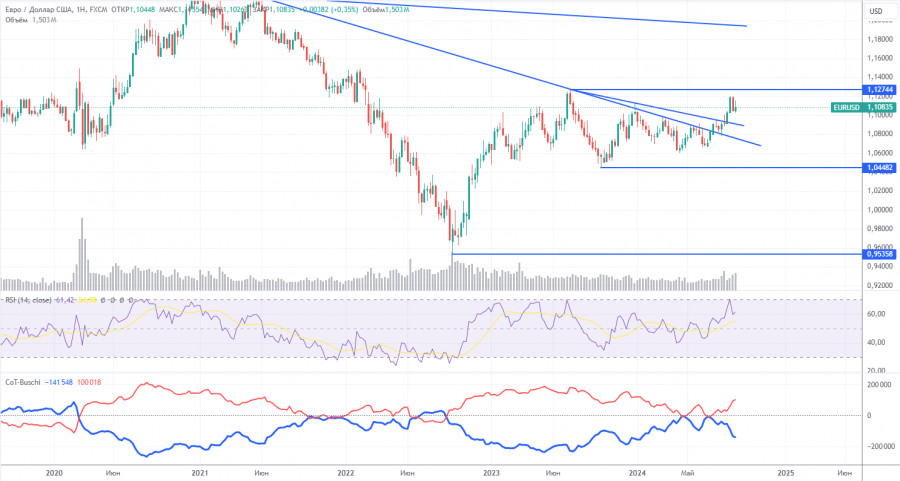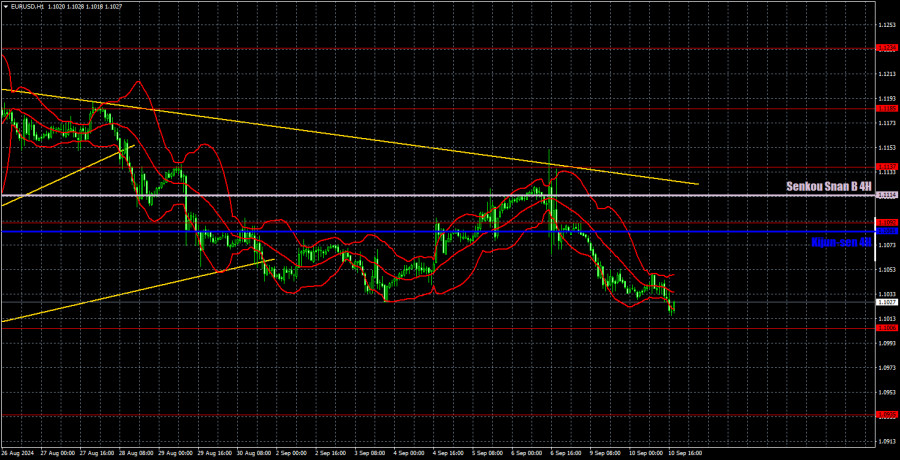Analysis of EUR/USD 5M

On Tuesday, the EUR/USD pair showed low volatility and little desire to move. The U.S. dollar made a very modest gain throughout the day, but its rise is a positive sign. The dollar is still finding it difficult to achieve any significant growth, so when it strengthens even without fundamental or macroeconomic support, it gives hope that the market may finally start trading more or less logically. On Monday, there were no important reports or events. The report on German inflation, with all due respect, wasn't considered crucial data. Inflation in Germany slowed to 1.9% in annual terms, as predicted and as indicated in the preliminary estimate. Therefore, there was no market reaction to this report.
Thus, the EUR/USD pair remains in a downward trend. This trend is likely to continue today, regardless of the U.S. inflation report. Even if the report is unfavorable for the dollar, the pair would need to rise by about 110 pips to overcome all the Ichimoku indicator lines and the trend line. Only in that case could we say that the current downtrend has been canceled. So, even if we see growth today, it is unlikely to affect the overall trend.
Not a single trading signal was formed yesterday. However, the day before, the price rebounded from the critical line, so the short position could have been closed on Monday evening, or one could wait for the nearest target level of 1.1006 to be reached. That said, it was not reached on Tuesday either. On Wednesday, the movement in the second half of the day could go in any direction.
COT report:

The latest COT report is dated September 3. The illustration above clearly shows that the net position of non-commercial traders has remained bullish for a long time. The bears' attempt to take over failed miserably. The net position of non-commercial traders (red line) declined in the second half of 2023 and the first of 2024, while commercial traders (blue line) grew. Currently, professional players are again increasing their long positions.
We also still do not see any fundamental factors supporting the strengthening of the euro. Technical analysis indicates that the price is in a consolidation phase—in other words, a flat. In the weekly time frame, it is clear that since December 2022, the pair has been trading between levels 1.0448 and 1.1274. In other words, we have moved from a seven-month flat into an 18-month one.
At the moment, the red and blue lines are slightly moving away from each other, which indicates that long positions on the euro are increasing. However, such changes cannot be the basis for long-term conclusions within a flat market. During the last reporting week, the number of long positions in the non-commercial group decreased by 2,400, while the number of short positions fell by 9,600. Accordingly, the net position increased by another 7,200. Yet, there is still potential for the euro to fall.
Analysis of EUR/USD 1H

In the hourly time frame, the EUR/USD pair finally has a real chance to end the baseless upward trend from eight months to two years. A new downtrend has formed, which is currently short-term. Since the Federal Reserve meeting is still a week away, the market could resume the relentless selling of the U.S. currency. However, at least some technical grounds exist to expect a decline in the pair for now. The price is below the Ichimoku indicator line, opening some prospects for the U.S. dollar.
For September 11, we highlight the following levels: 1.0658-1.0669, 1.0757, 1.0797, 1.0843, 1.0889, 1.0935, 1.1006, 1.1092, 1.1137, 1.1185, 1.1234, 1.1274, as well as the Senkou Span B (1.1114) and Kijun-sen (1.1085) lines. The Ichimoku indicator lines can move during the day, so this should be considered when identifying trading signals. Remember to set a Stop Loss to break even if the price has moved in the intended direction by 15 pips. This will protect you against potential losses if the signal turns out to be false.
On Wednesday, the U.S. inflation report for August will be released, and it's essentially the only report of the day. However, it could influence the pair's movement tomorrow and in the coming weeks. It might.
Explanation of illustrations:
Support and resistance levels: Thick red lines near which the trend may end.
Kijun-sen and Senkou Span B lines: These Ichimoku indicator lines, transferred from the 4-hour timeframe to the hourly chart, are strong lines.
Extreme levels: Thin red lines from which the price previously bounced. These provide trading signals.
Yellow lines: Trend lines, trend channels, and other technical patterns.
Indicator 1 on COT charts: The net position size for each category of traders
The material has been provided by InstaForex Company - www.instaforex.comfrom Forex analysis review https://ift.tt/LWxP4Vg
via IFTTT
